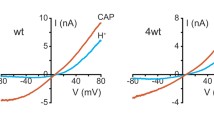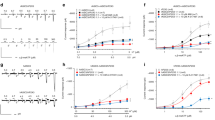Summary
-
1.
Extracellular ATP is recognized as a peripheral modulator of pain. Activation of ionotropic P2X receptors in sensory neurons has been implicated in induction of pain, whereas metabotropic P2Y receptors in potentiation of pain induced by chemical or physical stimuli via capsaicin sensitive TRPV1 channel. Here we report that P2Y2 receptor activation by ATP can activate the TRPV1 channel in absence of any other stimuli.
-
2.
ATP-induced Ca2 + signaling was studied in Neuro2a cells. ATP evoked release of intracellular Ca2 + from ER and Ca2 + influx through a fast inactivating channel. The Ca2 + response was induced by P2Y receptor agonists in the order of potency ATP ≥ UTP ≥ ATPγ S > ADP and was inhibited by suramin and PPADS. The P2X receptor agonist α β methyl ATP was ineffective.
-
3.
The Ca2 + influx was blocked by ruthenium red, an inhibitor of TRPV1 channel. Capsaicin, the most potent activator of the TRPV1 channel, evoked a fast inactivating Ca2 + transient suggesting the presence of endogenous TRPV1 channels in Neuro2a cells. NMS and PDBu, repressors of IP3 formation, drastically inhibited both the components of Ca2 + response.
-
4.
Our data show co-activation of the P2Y2 receptor and capsaicin sensitive TRPV1 channel by ATP. Such functional interaction between endogenous P2Y2 receptor and TRPV1 channels could explain the ATP-induced pain.
Similar content being viewed by others
Abbreviations
- ADP:
-
adenosine 5′-diphosphate
- AMP:
-
adenosine 5′-monophosphate
- ATP:
-
adenosine 5′-triphosphate
- ATPγS:
-
adenosine 5′-[γ -thio]triphosphate
- αβ methyl ATP:
-
α,β-methylene adenosine 5′-triphosphate
- 2 Me-S-ATP:
-
2(methyl thio) adenosine 5′-triphosphate
- CCE:
-
capacitative calcium entry
- CPA:
-
cyclopiazonic acid
- EGTA:
-
ethylene glycol-bis (2-aminoethylether)-N,N,N′,N′-tetraacetic acid
- GTP:
-
guanosine 5′-triphoshate
- IP3:
-
inositol 1,4,5-triphosphate
- NMS:
-
neomycin sulphate
- PDBu:
-
phorbol 12,13-dibutyrate
- PPADS:
-
pyridoxal phosphate-6-azo(benzene-2,4-disulfonic acid)
- PIP2:
-
phosphoinositol-4,5-bisphosphate
- PKC:
-
protein kinase C
- PLC:
-
phosholipase C
- PTx:
-
pertussis toxin
- SOC:
-
store-operated calcium entry
- TRPV:
-
transient receptor potential channel, subfamily V
- TRPC:
-
transient receptor potential channel, subfamily C
- UDP:
-
uridine 5′-diphoshate
- UTP:
-
uridine 5′-triphoshate
References
Burnstock, G., and Wood, J. N. (1996). Purinergic receptors: Their role in nociception and primary afferent neurotransmission. Curr. Opin. Neurobiol. 6:526–532
Carney, D. H., Scott, D. L., Gordon, E. A., and LaBelle, E. F. (1985). Phoshoinositides in mitogenesis: Neomycin inhibits thrombin-stimulated phoshoinositde turnover and initiation of cell proliferation. Cell 42:479–488.
Caterina, M. J. (2001). Quenching fire with fat: Phosphatidylinositides as putative regulators of pain. Trends Pharmacol. Sci. 22:602–604.
Caterina, M. J., and Julius, D. (2001). The vanilloid receptor: A molecular gateway to the pain pathway. Ann. Rev. Neurosci. 24:487–517
Chen, C. C., and Chen, W. C. (1997). P2Y receptor linked to phospholipase C: Stimulation of Neuro2a cells by UTP and ATP and possible regulation by protein kinase C subtype epsilon. J. Neurochem. 69:1409–1416.
Chizh, B. A., and Illes, P. (2001). P2X receptors and nociception. Pharmacol. Rev. 53:553–568.
Chuang, H. H., Prescott, E. D., Kong, H., Shields, S., Jordt, S. E., Basbaum, A. I., Chao, M. V., and Julius, D. (2001). Bradykinin and nerve growth factor release the capsaicin receptor from PtdIns (4,5)P2-mediated inhibition. Nature 411:957–962.
Cook, S. P., and McCleskey, E. W. (2002). Cell damage excites nociceptors through release of cytosolic ATP. Pain 95:41–47.
Fields, R. D., and Stevens, B. (2000). ATP: An extracellular signaling molecule between neuron and glia. Trends Neurosci. 23:625–633.
Fredholm, B. B. (1995). Purinoceptors in the nervous system. Pharmacol. Toxicol. 76:228–239.
Gunthorpe, M. J., Benham, C. D., Randall, A., and Davis, J. B. (2002). The diversity in the vanilloid (TRPV) receptor family of ion channels. Trends Pharmacol. Sci. 23:183–191.
Hamilton, S. G., and McMahon, S. B. (2000). ATP as a peripheral mediator of pain. J Auton. Nerv. Syst. 81:187–194.
Illes, P., and Alexandre Ribeiro, J. (2004). Molecular physiology of P2 receptors in the central nervous system. Eur. J. Pharmacol. 483:5–17.
Joshi, P. G., and Mishra, S. (1998). A novel type of Ca2+ channel activated by antibody to galactocerebroside in U-87 MG cells. Life Sci. 62:409–444.
Khakh, B. S., Burnstock, G., Kennedy, C., King, B. F., North, R. A., Seguela, P., Voigt, M., and Humphrey, P. P. A. (2001). International union of pharmacology XXIV. Current status of the nomenclature and properties of P2X receptors and their subunits. Pharmacol. Rev. 53:107–118.
King, B. F., Townsend-Nicholson, A., and Burnstock, G. (1998). Metabotropic receptors for ATP and UTP: Exploring the correspondence between native and recombinant nucleotide receptors. Trends Pharmacol. 19:506–514.
Kiselyov, K., Xu, X., Mozhayeva, G., Kuo, T., Pessah, I., Mignery, G., Zhu, X., Birnbaumer, L., and Muallem, S. (1998). Functional interaction between InsP3 receptors and store-operated Htrp3 channels. Nature 396:478–482.
Moriyama, T., Iida, T., Kobayashi, K., Higashi, T., Fukuoka, T., Tsumura, H., Leon, C., Suzuki, N., Inoue, K., Gachet, C., Noguchi, K., and Tominaga, M. (2003). Possible involvement of P2Y2 metabotropic receptors in ATP-induced transient receptor potential vanilloid receptor 1-mediated thermal hypersensitivity. J. Neurosci. 23:6058–6062.
Nakamura, F., and Strittmatter, S. M. (1996). P2Y1 purinergic receptors in sensory neurons: Contribution to touch-induced impulse generation. Proc. Natl. Acad. Sci. USA. 93:10465– 10470.
Neary, J. T., Rathbone, M. P., Cattabeni, F., Abbrachio, M. P., and Burnstock, G. (1996). Trophic actions of extracellular nucleotides and nucleosides on glial and neuronal cells. Trends Neurosci. 19:13–18.
Nishizuka, Y. (1992). Intracellular signaling by hydrolysis of phospholipids and activation of protein kinase C. Science 258: 607–614.
North, R. A. (2002). Molecular physiology of P2X Receptors. Physiol Rev. 82:1013–1067.
Ohta, T., Morishita, M., Mori, Y., and Ito, S. (2004). Ca2+ store-independent augmentation of [Ca2+]i responses to G-protein coupled receptor activation in recombinantly TRPC5-expressed rat pheochromocytoma (PC12) cells. Neurosci. Lett. 358:161–164.
Olsson, R. A., and Pearson, J. D. (1990). Cardiovascular purinoceptors. Physiol. Rev. 70:761–845.
Premkumar, L. S., and Ahern, G. P. (2000). Induction of vanilloid receptor channel activity by protein kinase C. Nature 408:985–990.
Putney, J. W., Jr. (2003). Capacitative calcium entry in the nervous system. Cell Calcium 34:339–344.
Ralevic, V., and Burnstock, G. (1998). Receptors for purines and pyrimidines. Pharmacol. Rev. 50:413–492.
Rathbone, M. P., Middlemiss, P. J., Gysbers, J. W., Andrew, C., Herman, M. A., Reed, J. K., Ciccarelli, R., Di Iorio, P., and Caciagli, F. (1999). Trophic effects of purines in neurons and glial cells. Prog. Neurobiol. 59:663–690.
Ravichandra, B., and Joshi, P. G. (1999). Regulation of transmembrane signaling by ganglioside GM1: Interaction of anti-GM1 with Neuro2a cells. J. Neurochem. 73:557–567.
Sanada, M., Yasuda, H., Omatsu-Kanbe, M., Sango, K., Isono, T, Matsuura, H., and Kikkawa, R. (2002). Increase in intracellular Ca2+ and calcitonin gene-related peptide release through metabotropic P2Y receptors in rat dorsal root ganglion cells. Neuroscience 111:413–422.
Santos, A. R., and Calixto, J. B. (1997). Ruthenium red and capsazepine antinociceptive effect in formalin and capsaicin models of pain in mice. Neurosci. Lett. 235:73–76.
Tominaga, M., Wada, M., and Masu, M. (2001). Potentiation of capsaicin receptor activity by metabotropic ATP receptors as a possible mechanism for ATP evoked pain and hyperalgesia. Proc. Natl. Acad. Sci. USA. 98:6951–6956.
Tsuda, M., Ueno, S., and Inoue, K. (1999). Evidence for the involvement of spinal endogenous ATP and P2X receptors in nociceptive responses caused by formalin and capsaicin in mice. Br. J. Pharmacol. 128:1497–1507.
Vellani, V., Mapplebeck, S., Moriondo, A., Davis, J. B., and McNaughton, P. A. (2001). Protein kinase C activation potentiates gating of the vanilloid receptor VR1 by capsaicin, protons, heat and anandamide. J. Physiol. 534:813–825.
Wildman, S. S., Unwin, R. J., and King, B. F. (2003). Extended pharmacological profiles of rat P2Y2 and rat P2Y4 receptors and their sensitivity to extracellular H+ and Zn2+ ions. Br. J. Pharmacol. 140:1177–1186.
Zitt, C., Halaszovich, C. R., and Luckhoff, A. (2002). The TRP family of cation channels: Probing and advancing the concepts on receptor-activated calcium entry. Prog. Neurobiol. 66:243–264.
Author information
Authors and Affiliations
Rights and permissions
About this article
Cite this article
Lakshmi, S., Joshi, P.G. Co-activation of P2Y2 Receptor and TRPV Channel by ATP: Implications for ATP Induced Pain. Cell Mol Neurobiol 25, 819–832 (2005). https://doi.org/10.1007/s10571-005-4936-8
Received:
Accepted:
Issue Date:
DOI: https://doi.org/10.1007/s10571-005-4936-8




